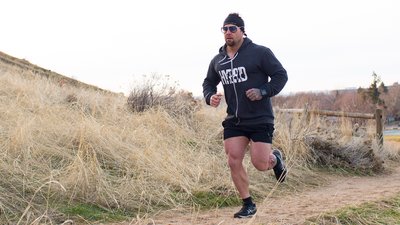Many athletes act like running and bodybuilding are mutually exclusive. Do one, and not only is it unlikely that you do the other, but it may be downright impossible. "You'll run away your gains," one side will tell you. The other side will swear that a muscular man on the road is like a fish out of water—and he'll be gasping just like one in a matter of miles.
I set out to disprove both arguments when I began training for my first Ironman triathlon, which I've documented in the Man of Iron video series. I continued to train like a bodybuilder, and I continued to succeed with my bodybuilding goals.
This wasn't by accident, though. Like most bodybuilders, I'm a lot heavier than the average endurance athlete, and I had to adjust my training accordingly. Here's everything I've learned about running alongside my bodybuilding lifestyle.
Lesson 1: Muscle Doesn't Melt Away!
I'm living, lifting, running proof that with the right diet and supplement regimen, "having it all" is possible. Sure, if somebody does nothing but high-volume endurance running, neglects weight training, and follows a low-protein diet, it will cause muscle loss. However, my diet is as it's always been: high in protein, high in complex carbohydrates, and moderate in fat. More than ever, I paid attention to inflammation and gut health, reducing stress on my body, and heightening my state of recovery. And it paid off.
My meal frequency remained high with six solid meals per day, along with my Kaged Muscle Re-Kaged after every workout and supplementing with Kasein before bed. The former gives me a fast-digesting protein with added amino acids, making it the perfect post-workout recovery choice. The latter gives me the opposite: a blend of slow-release amino acids, gradually feeding my muscles through the night.
The takeaway for you: If your nutrition is locked down, your body can thrive during all types of challenges.
Lesson 2: Running is Great for Gym Performance
Most bodybuilders I've trained with are strong, but they seriously lack endurance. This usually has a significant impact on their ability to break through the intensity barrier that I always chase. Endurance running has heightened my lung capacity and the efficiency of my heart significantly, and I find that it shows in the weight room!
The boost from my running—and cycling—is particularly helpful for recovery between sets while using higher rep ranges on larger body parts, such as legs and back. Arnold himself noted in the "Encyclopedia of Modern Bodybuilding" that doing heavy squats is "like running a mini-marathon." And after I walk out of the weight room, I find my recovery is also improved. My heart can pump blood to the damaged muscle fibers more easily, helping remove toxins and lactic acid while constantly transporting nutrients to the localized areas of damage.

Lesson 3: Running is Healthy
My goal is to live to 100, which requires more than aesthetics. On a regular basis, I get my blood work done, as well as food allergy tests, to assess how my current habits are affecting my health. I'm very pleased to say that since doing more endurance training in preparation for my Ironman, my health markers are better than ever.
Endurance running has imparted demonstrable health benefits to my heart, lungs, blood pressure, cholesterol, and even gut function. As someone who believes that health should always be the number-one priority, this got my attention.
Lesson 4: Running Has to be Done Right!
To me, the benefits of running are obvious. However, as somebody who is around 60 pounds heavier than a typical endurance runner, I've had to learn how to help my body cope with the stress—and specifically, my joints. It's not enough to run, I must run correctly.
This means using a forefoot or mid-foot strike, rather than landing on my heels with each step, to avoid excessive stress on my Achilles tendons, knees, and calves. Since my thighs are bigger than the average guy, they are prone to fatiguing more quickly. This makes focusing on the correct foot strike even more important.
I also added a lot of focus to building the strength of my hip flexors. The goal here was to keep my legs moving forward as I run longer distances, instead of bouncing up and down through plantar-flexion of the calf. Every distance runner can probably benefit from having stronger hip flexors, but for me, it's non-negotiable. I also complete most of my runs on trails and softer surfaces to lessen the impact.
But that's only my bottom half. What happens above the belt matters when running, too. First and foremost, I avoid excessive arm movement. Instead, I like to pivot my upper body with my lower body in opposite directions with each stride. To ensure my posture remains upright, I visualize having a sphere in my stomach, which will fall out if I tilt forward or to either side. This means I simply can't let my posture drop.
Don't Run Away from Good Health!
There are so many benefits to endurance running that it's a shame so many of my iron brethren don't experience them. Let my journey enlighten you as to what's possible, and help you become an all-around athlete who can move as well as turn heads in the gym. It's better for your health, it's mentally stimulating, and the challenge builds character!

